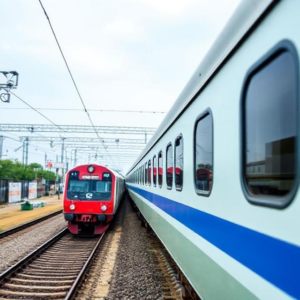What is ATI (Automatic Train Identification)?
ATI is a technology used by railways to automatically track and identify trains as they move along the tracks. It’s like a train’s “ID card” that helps the railway system know which train is where, at any given time, without needing to rely on manual checks.

How Does ATI Work?
- Train Identification: Each train is fitted with an electronic tag (or a device) that has a unique ID number. This tag can communicate with trackside equipment to automatically send its identification information.
- Trackside Equipment: Special devices are installed along the railway tracks, usually near signals, junctions, or stations. These devices are capable of detecting the train’s ID by reading the electronic tag on the train. The device records information like:
- Which train it is.
- Where the train is located (which part of the track).
- The time it passed that location.
- Data Communication: Once the train passes a trackside device, this information is sent to a central control system (like a train operations center). This system knows the position and ID of all trains on the network in real-time.
- Real-Time Monitoring: The system constantly updates the position of every train. This helps operators monitor train movements in real time, ensuring trains don’t collide, and that train schedules are followed.
Components of ATI Systems:
- Train Tags/Onboard Units: These are the devices installed on trains. They have a unique identification code (like a serial number) that tells the system which train it is. These devices are similar to an RFID (Radio Frequency Identification) tag that communicates wirelessly.
- Trackside Readers: These are sensors or readers placed on the tracks or near stations. They detect the unique ID of a passing train and send this information to the control center.
- Control Center: This is the place where all the data is collected and analyzed. The control center can track the location and movement of each train, helping operators make decisions like rerouting or stopping trains.
- Communication System: This system allows the data to be sent from trackside readers to the control center. It could be done through wired or wireless communication networks, ensuring that the data is received in real time.
How ATI Improves Train Operations:
- Track Train Locations: ATI helps railway operators know the exact location of a train at all times. This helps prevent accidents by ensuring there are no conflicts or crashes on the tracks.
- Automatic Monitoring: With ATI, there’s no need for workers to manually check or report train locations. The system automatically tracks each train, making it more efficient and accurate.
- Improved Safety: By continuously monitoring trains, ATI systems can help identify if a train is going off schedule, entering restricted areas, or is in danger of colliding with another train. This helps prevent accidents.
- Better Scheduling: ATI allows the control center to adjust schedules dynamically based on train positions, delays, or issues. If one train is delayed, it can help manage the schedules of others to reduce delays across the network.
- Increased Efficiency: With real-time data, operators can optimize train movements, reduce congestion on the tracks, and improve overall efficiency. It also helps with predictive maintenance, allowing operators to know when a train might need repairs based on its usage and performance.
Real-World Example:
One example of an ATI system is the European Train Control System (ETCS), which uses automatic train tracking to monitor trains in real-time and help with things like train safety, speed control, and preventing collisions. Similarly, many metro and suburban train systems around the world use ATI systems to track their trains and improve operations.
Benefits of ATI Systems:
- Safety: Ensures trains are where they are supposed to be and prevents accidents due to train collisions or running red signals.
- Efficiency: Helps the control center manage train schedules, reducing delays and making the railway network work more smoothly.
- Automatic Data Collection: Reduces the need for manual inspections, saving time and effort, and giving operators up-to-date information automatically.
- Better Decision Making: The system provides operators with detailed information on train locations, which helps them make better decisions about train routes, delays, and safety measures.
Conclusion:
In simple terms, Automatic Train Identification (ATI) is like a smart system that helps railways keep track of every train in real time. It uses technology to identify trains, track their location, and send this information to control centers. This makes train operations safer, faster, and more efficient. It’s like having a constant update on where every train is and ensuring everything runs smoothly without relying on manual tracking or guesswork.
Keywords: Automatic Train Identification, Railway











